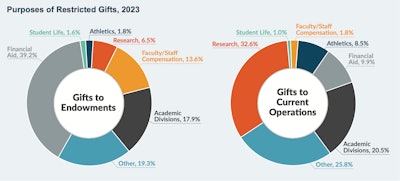Giving to U.S. higher education institutions was $58 billion in the fiscal year ending June 30, 2023. Although this represents a 2.5 percent decline from the record high reported in 2022, it demonstrates continued significant philanthropic support to the important higher education sector. The annual survey results were released today by the Council for Advancement and Support of Education (CASE) in a research brief.
The CASE InsightsSM on Voluntary Support of Education (VSE) survey is the definitive source of data about philanthropic support for nonprofit and public higher education institutions in the U.S.
 CASE InsightsSM on Voluntary Support of Education SurveyCouncil for Advancement and Support of Education
CASE InsightsSM on Voluntary Support of Education SurveyCouncil for Advancement and Support of Education
However, institutions saw declines in giving from individuals declined; gifts for capital purposes — supporting the physical and economic infrastructure of institutions — declined.
“The philanthropic investment of over $58 billion in higher education institutions in the United States last year should be a source of celebration and pride,” said Sue Cunningham, president and CEO of CASE.
“That so many individuals and organizations support colleges and universities indicates nationwide recognition of the immense value these institutions provide through transforming lives and society,” she continued.
The data collected on CASE InsightsSM surveys allow each institution to understand trends in its own performance over time and to benchmark with like institutions, according to Cara Giacomini, vice president of data, research, and technology at CASE. She said national data provide an overview of what occurred in the aggregate, but each institution has its unique set of relevant metrics.
CASE reported that the number of gifts totaling $100 million or more was higher than in 2022, the year institutions raised the most from gifts. There were 11 gifts of such magnitude in 2023, accounting for 3.9% of total support. That is more than double these gifts’ weight in 2022, when seven such contributions accounted for 1.8% of the total.
The survey found that much of the endowed support was targeted by donors to fund student financial aid, academic divisions, and faculty and staff compensation. Smaller outright gifts tended to be restricted to current operations, with the largest percentage earmarked for research.
“Kudos to the many who choose to give and to those working in institutions that educate future generations and undertake research to save and improve lives,” said Cunningham.


















